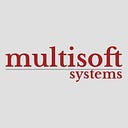SAP BRIM Interview Insights: Online Training Course with 10 Common Questions Answered
Course Overview
The SAP Billing and Revenue Innovation Management (BRIM) Online Training Course offered by Multisoft Systems is a comprehensive program designed to provide participants with in-depth knowledge and skills in SAP BRIM. SAP BRIM is a powerful solution that enables organizations to streamline their billing and revenue management processes. The course covers various aspects of SAP BRIM, including key components, functionalities, pricing models, integration with other SAP systems, subscription management, revenue recognition, and payment processes.
In today’s rapidly evolving business landscape, efficient billing and revenue management plays a crucial role in ensuring financial stability and growth. SAP Billing and Revenue Innovation Management (BRIM) is a powerful solution that enables organizations to streamline their billing processes and optimize revenue generation. Multisoft Systems offers a comprehensive SAP BRIM Online Training Course, designed to equip professionals with the knowledge and skills required to excel in this domain. In this article, we will delve into 10 common interview questions related to SAP BRIM and provide insightful answers to help you succeed in your interviews with confidence.

10 common interview questions are:-
Q1. What is SAP BRIM, and how does it benefit organizations?
SAP BRIM (Billing and Revenue Innovation Management) is an end-to-end solution that integrates various billing and revenue management processes. It helps organizations automate complex billing scenarios, optimize revenue streams, and enhance customer experience. SAP BRIM offers features like flexible pricing models, subscription management, revenue recognition, and real-time analytics.
Q2. What are the key components of SAP BRIM?
SAP BRIM consists of several key components, each serving a specific function. These components include Convergent Invoicing, Convergent Charging, Contract Accounts Receivable, and Payable, and Subscription Order Management. Convergent Invoicing manages complex invoicing processes, Convergent Charging handles usage-based billing, Contract Accounts Receivable and Payable manages customer accounts, and Subscription Order Management enables subscription-based billing and management.
Q3. How does SAP BRIM integrate with other SAP systems?
SAP BRIM seamlessly integrates with other SAP systems to ensure data consistency and streamline business processes. It integrates with SAP Customer Relationship Management (CRM) for customer data management, SAP Sales and Distribution (SD) for order management, SAP Financial Accounting (FI) and Controlling (CO) for financial integration, and SAP HANA for real-time analytics.
Q4. Can you explain the pricing models supported by SAP BRIM?
SAP BRIM supports various pricing models to cater to different business requirements. These include one-time pricing, recurring pricing, tiered pricing, volume-based pricing, and usage-based pricing. One-time pricing is suitable for products or services with a fixed price while recurring pricing is ideal for subscription-based offerings. Tiered pricing allows organizations to offer different pricing levels based on quantities or tiers.
Q5. How does SAP BRIM handle complex billing scenarios?
SAP BRIM is designed to handle complex billing scenarios efficiently. It offers robust functionality for managing diverse billing processes, including advanced invoicing, revenue recognition, and financial integration. SAP BRIM supports the management of complex pricing structures, discounts, taxes, and multiple payment methods. It enables organizations to generate accurate and detailed invoices, track revenue recognition, and seamlessly integrate billing data with financial systems.
Q6. How does SAP BRIM facilitate subscription management?
SAP BRIM enables organizations to effectively manage subscriptions and recurring services. It provides capabilities for subscription order management, including subscription creation, modification, and cancellation. SAP BRIM supports flexible subscription models, billing cycles, and billing frequencies. It automates the subscription billing process, calculates prorated charges, and handles upgrades or downgrades.
Q7. What are the key benefits of implementing SAP BRIM?
Implementing SAP BRIM offers several benefits to organizations. It enhances billing accuracy and reduces errors by automating complex billing processes. SAP BRIM improves revenue visibility, enabling organizations to have real-time insights into revenue streams. It streamlines revenue processes, reducing billing cycle times and improving operational efficiency.
Q8. Can SAP BRIM integrate with external billing systems?
Yes, SAP BRIM can integrate with external billing systems through standard interfaces and APIs. This integration allows organizations to consolidate billing data from different systems into SAP BRIM, ensuring a centralized and streamlined billing process. SAP BRIM can also push billing data to external systems for financial reporting or further processing.
Q9. How can SAP BRIM contribute to revenue optimization?
SAP BRIM helps organizations optimize revenue by streamlining billing processes, ensuring accurate and timely invoicing, and improving revenue visibility. It enables organizations to implement flexible pricing models, effectively manage contracts, and automate revenue recognition.
Q10. What are the career prospects for professionals skilled in SAP BRIM?
Professionals skilled in SAP BRIM can explore diverse career opportunities in billing and revenue management roles. They can pursue roles such as SAP BRIM Consultant, Billing Specialist, Revenue Analyst, or Revenue Manager.
Conclusion
The SAP Billing and Revenue Innovation Management (BRIM) Online Training Course by Multisoft Systems equips professionals with the knowledge and skills required to excel in SAP BRIM interviews. By mastering the concepts, functionalities, and best practices of SAP BRIM, individuals can position themselves for rewarding career opportunities and competitive salaries in the dynamic field of billing, corporate training, and revenue management.
